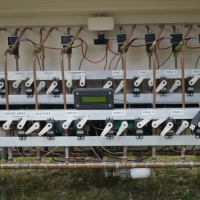What will it take for the Prop 1 to support WebDAV?
 dbpage
Posts: 217
dbpage
Posts: 217
in Propeller 1
I would like to 'mount' an SD card in my Propeller project to the file system of a host PC (e.g., Win, Mac, Linux). What will it take on the Propeller side to do that?


Comments
What that has to do with mounting file systems, on SD card or whatever, I have no idea.
https://en.wikipedia.org/wiki/WebDAV
I'm certainly interested to find out if a Propeller can handle all the code for SD, FAT16/32, HTTP, and WebDAV. I can't imagine it'll do it in 32k of program space, so you'll need some kind of external program memory and a kernel to load from it.
Are you sure you want to use WebDAV and not something else? Peter's Tachyon comes with FTP which might be far better suited to your needs.
There are some Spinneret threads about WebDAV. I would rather not turn my project into a web server to implement http so I can use WebDAV to mount my SD Card. I prefer something more direct.
I want to be able to connect my Propeller project to a PC or Mac, open Finder or Explorer on the PC or Mac, mount the SD Card, browse the directory, find a file and copy/paste the file. I do *not* need a directory structure. A flat directory will suffice.
I am looking for something a bit more elegant than simple file transfer software.
Is a wifi/ethernet connection necessary?
?
So what do you need , that FTP & Telnet & HTTP can not provide?
It a very odd protocol. Basically a extension of HTTP, but needs NetBIOS for name resolution (already 2 sockets) plus parts of the SMB protocol.
As usual for MS extensions of everything it is not as well documented as you wish for and even the differences between 'mounting' from file-explorer or Word and Excel can drive you nuts. Put a Linux client in the mix and watch your hair getting grayer every minute.
I simply ran out of hub-space and available sockets.
Using FTP as Peter does in Tachyon is a better solution for the P1.
Enjoy!
Mike
Peter is just not bragging much about his products. Not sure why, because the few he gave information about are quite useful and impressive.
Enjoy!
Mike
Don't bother using Tachyon unless you are willing to learn a complete stand alone Forth development environment and become ultra productive like Peter is not to mention getting all your questions answered regarding hardware, software and deployment using Tachyon and FORTH. /sarc
What are the advantages of Tachyon?
Disadvantages?
forums.parallax.com/discussion/141061/tachyon-o-s-v3-0-juno-furiously-fast-forth-fat32-lan-vga-rs485-obex-roms-fp-lmm#latest
have a look at the Tachyon thread:
forums.parallax.com/discussion/141061/tachyon-o-s-v3-0-juno-furiously-fast-forth-fat32-lan-vga-rs485-obex-roms-fp-lmm#latest
What are the advantages of Tachyon?
- fast
- compact
- interactive
- proven in commercial projects
- loads of code from Peter
- SD/NW/FTP/HTTP/Telnet/RS485-NW/...................
Disadvantages?
- new language AND new thinking for most programmers
- learning curve
Self contained environment, just need a console; minicom, teraterm, zterm...
Save entire image a as bin file so you can reload as necessary.
Software RTC, watchdog and cascading user timer with alarm and routine callbacks.
Console alive during "system" on to monitor, poke and peek at system.
HTTP, FTP, TELNET access
SD Card Access Fat32 support, not complete but nothing missing I have ever missed having.
RS485 like master slave console access to each node.
System can be broken into Modules for ease of maintenance and code reuse (chip drivers usually) in there own modules.
Built in VGA support.
OBEX PASM modules can be incorporated as ROMs now i.e. for me I have access to F32 floating point although we are missing console float IO i.e 123.764 -> 32b HEX 32b Hex -> 123.764
Backup and restore.
Lazy background polling in main console of up to eight cascaded tasks
Peter, MJB and others are talented and helpful on the lists.
much more
Cons
People tend to hate on Forth because it is not "new shinny" without realizing it's just not a language. It's a complete development environment/methodology designed to concentrate on the problem and not waste time on the accidental complexity of the tool chain.
If you are only trained in "languages" such as C, C++, C#, Pascal, Spin, Ada, Javascript, CSS, HTML, SQL and some ASM like I was then working in Forth/Tachyon initially can be a real brain ache to break the problem down into good Tachyon/Forth.
Tachyon/Forth is not standards compliant so some people complain that it's not portable as if you're gonna be using code from the prop and put in on a mainframe or even on another micro with interrupts. This can be said for any language on the Prop though, you can't just wish PASM cog code into cascading interrupt routines on another micro.
I'm sure there are some more cons.
Tachyon works for me, just my opinion. But use the right tool for YOU and the job, I'm not doing professional dynamic web development and SAP module development using Forth.
1) interactive development
2) quite fast byte code
3) forth is a very efficient language if you can wrap your head around this RPN like data stack
disadvantages of Tachion are
1) its FORTH, so unlike every other language you ever met, except HP-Calculators.
2) like every other FORTH it is build around the target machine, so not really portable. Alas Peter keeps P1 and P2 quite near as possible.
3) FORTH seems to be a write only language if you can NOT wrap your head around this RPN like data stack
Basically it boils down to YOU getting along with that way of thinking you need to program in FORTH. Either you can grook it or you don't.
I sadly failed there, to much COBOL thinking and such.
But if you don't tried you should. Some people get it in minutes, other never (like me)|
Enjoy!
Mike
PRO: full source available - and modifyable as you like - if you can ;-)